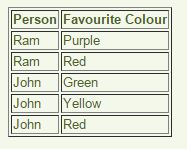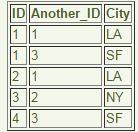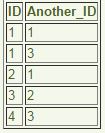Users Online
· Guests Online: 7
· Members Online: 0
· Total Members: 188
· Newest Member: meenachowdary055
· Members Online: 0
· Total Members: 188
· Newest Member: meenachowdary055
Forum Threads
Newest Threads
No Threads created
Hottest Threads
No Threads created
Latest Articles
Articles Hierarchy
Multiple Choice Questions on Normalization
Multiple Choice Questions on Normalization
1. A table is in BCNF if it is in 3NF and if every determinant is a ............... key.
A) dependent
B) normal
C) candidate
D) Both B & C
2. The ....................... introduced by Chris Date, Hugh Darwen, and Nikos Lorentzos.
A) Third
B) Fourth
C) Fifth
D) Sixth
3. Below table is in First Normal Form:

A) True
B) False
4. In Case of Database normalization the order of the rows and columns is immaterial;
A) True
B) False
5. A table is in 3NF if it is in 2NF and if it has no ......................
A) functional dependencies
B) transitive dependencies
C) trivial functional dependency
D) multivalued dependencies
6.
Every constraint on the table is a logical consequence of the table's ......
A) Fourth normal form
B) Fifth normal form
C) Domain/key normal form
D) None of above
7. A ................. is an indirect functional dependency, one in which X→Z only by virtue of X→Y and Y→Z.
A) multivalued dependencies
B) join dependency
C) trivial functional dependency
D) transitive dependencies
8. In a given relationship R, if an attribute A uniquely defines all other attributes, then the attribute A is a key attribute which is also known as the .......... key.
A) candidate
B) join
C) functional
D) None of above
9. In order to convert the Main table to 2nd normal form we have split it into two tables Split_1 and Split_2. Split_1 and Split_2 are now in 2nd normal form:
Main Table

Split_1

Split_2

A) True
B) False
10. Anomalies are avoided by splitting the offending relation into multiple relations, is also known as ....................
A) Accupressure
B) Decomposition
C) Precomposition
D) Both b & c
1. A table is in BCNF if it is in 3NF and if every determinant is a ............... key.
A) dependent
B) normal
C) candidate
D) Both B & C
2. The ....................... introduced by Chris Date, Hugh Darwen, and Nikos Lorentzos.
A) Third
B) Fourth
C) Fifth
D) Sixth
3. Below table is in First Normal Form:

A) True
B) False
4. In Case of Database normalization the order of the rows and columns is immaterial;
A) True
B) False
5. A table is in 3NF if it is in 2NF and if it has no ......................
A) functional dependencies
B) transitive dependencies
C) trivial functional dependency
D) multivalued dependencies
6.
Every constraint on the table is a logical consequence of the table's ......
A) Fourth normal form
B) Fifth normal form
C) Domain/key normal form
D) None of above
7. A ................. is an indirect functional dependency, one in which X→Z only by virtue of X→Y and Y→Z.
A) multivalued dependencies
B) join dependency
C) trivial functional dependency
D) transitive dependencies
8. In a given relationship R, if an attribute A uniquely defines all other attributes, then the attribute A is a key attribute which is also known as the .......... key.
A) candidate
B) join
C) functional
D) None of above
9. In order to convert the Main table to 2nd normal form we have split it into two tables Split_1 and Split_2. Split_1 and Split_2 are now in 2nd normal form:
Main Table

Split_1

Split_2

A) True
B) False
10. Anomalies are avoided by splitting the offending relation into multiple relations, is also known as ....................
A) Accupressure
B) Decomposition
C) Precomposition
D) Both b & c
Page 1 of 2: 12
Comments
No Comments have been Posted.
Post Comment
Please Login to Post a Comment.

